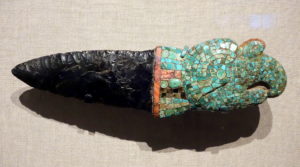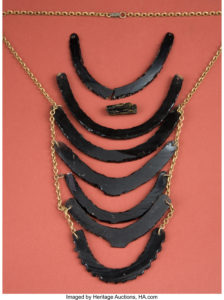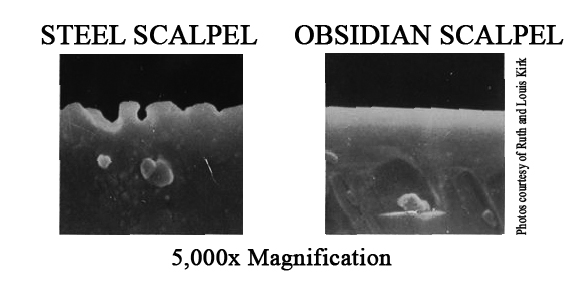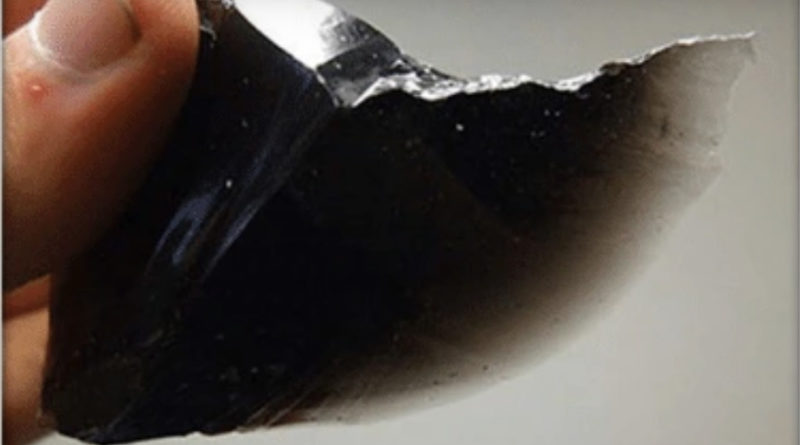Jalisco obsidian: an ancient and modern-day marvel
By Kristina Morgan
Obsidian is a naturally occurring volcanic glass formed into a kind of rock by the rapid cooling of lava. The majority of obsidian is black or gray but a rarer green obsidian was prized for works of art and their most valuable weapons. Ancient uses of obsidian are being challenged by today’s choice of obsidian as a surgical tool, offering one of the finest edges that nanotechnology can produce.
 In the Sierra de las Navajas (Razor or Knife mountains translated into English) about two hours outside of Lake Chapala, is a modern mine that recently crossed paths with pre-Hispanic tunnels used to quarry obsidian by the Aztecs. Archeologists agree that this is one of the largest and most important obsidian deposits in Central Mexico, offering the rare green obsidian.
In the Sierra de las Navajas (Razor or Knife mountains translated into English) about two hours outside of Lake Chapala, is a modern mine that recently crossed paths with pre-Hispanic tunnels used to quarry obsidian by the Aztecs. Archeologists agree that this is one of the largest and most important obsidian deposits in Central Mexico, offering the rare green obsidian.
Legendary Stone of the Aztecs
Obsidian was known as the “Stone of the Gods.” As the story goes, a beautiful young woman named Xochitzol (sun flower) fell in love with a great warrior. Her father, a priest, did not want them to get married so he sent her lover to war. As they were saying goodbye, they climbed to the top of the Sierra de las Navajas and Xochitzol swore that she would never marry until her beloved returned.
When he didn’t return, she climbed the mountain and began to cry without stopping. One of the gods asked her why she was crying, and she told him of her lost love. When the god asked her how he could help her, Xochitzol asked him: “May my tears become a beacon of light for when my beloved returns.” Her tears became representative of the enormous Obsidian deposits in the area.

It was one of the main objects valued and traded among the Aztecs, Teotihuacan and Toltecs, but obsidian reached its pinnacle of pre-Columbian development in the hands of the Aztecs.
Besides being used in weaponry, obsidian is a semiprecious stone, which can be polished. This greatly added to its importance, especially because the Aztec royalty and aristocracy wore obsidian jewelry and Aztec priests polished the obsidian to a mirror-like sheen and claimed to divine the future with it. They believed that obsidian, like everything in nature, had a spirit. Obsidian was believed to protect its owner, so Aztecs would place an obsidian knife in water in the courtyard of their home to keep sorcerers away because it was believed that they were frightened by their own reflections.
Molecular Thinness and Sharpness
The Aztecs believed in ritual sacrifice and self-mutilation to appease their gods. Many have questioned how the Aztecs could be so willing to undergo the pain of cutting themselves but it’s now known that a fresh obsidian blade is so sharp that the cut is barely felt and the blade approaches molecular thinness. In Lake Chapala, we still find small clay pots which were used to catch the blood from cuts in their ears and tongues to appease Tlaloc, the rain god, which were then thrown into the lake as an offering.
 Obsidian is 15 times sharper than surgical steel, It’s no wonder that obsidian became a valuable tool in medicine and warfare when you consider that at an obsidian scalpel can rival diamond in the fineness of its edge. Our common household razor blades are 100 times thicker than obsidian.
Obsidian is 15 times sharper than surgical steel, It’s no wonder that obsidian became a valuable tool in medicine and warfare when you consider that at an obsidian scalpel can rival diamond in the fineness of its edge. Our common household razor blades are 100 times thicker than obsidian.
Obsidian in Modern-Day Surgery
Dr. Lee Green, professor and chairman of the Department of Family Medicine at the University of Alberta, says he routinely uses obsidian blades in surgery. “The biggest advantage with obsidian is that it is the sharpest edge there is, it causes very little trauma to tissue, it heals faster, and more importantly, it heals with less scarring,” he said.”
Green once worked with documentary producers in Egypt to do a blind test on the difference between obsidian scalpels and surgical steel scalpels. “It wasn’t hard to tell the difference at all. As soon as he turned around, everyone in the studio was like ‘Ohhh,’ ” Green said. “Under the microscope, you could see the obsidian scalpel had divided individual cells in half, and next to it, the steel scalpel incision looked like it had been made by a chainsaw.”
Today, obsidian blades are most often used in cardiac and eye surgery, due to the precision of the incision, which allows for rapid healing and minimal scarring.
Obsidian is still fairly new in modern medicine but the history of this glass rock abundantly found in central Mexico has come full circle in terms of its usefulness and value. Maybe “Xochitzol’s tears” weren’t wasted after all.
Sources: Dr Lee Green via CNN
***
 ABOUT THE AUTHOR: Kristina Morgan
ABOUT THE AUTHOR: Kristina Morgan
Kristina has lived in Mexico and the Lake Chapala area for 18 years. Three of her four children were born and raised here. She once served as a Relocation Specialist and Public Relations Director for Focus on Mexico and is a Licensed Real Estate Broker and also a Licensed General Contractor. She is currently working as a co-broker at Lake Chapala Real Estate in Ajijic. Kristina is also known for her popular Facebook page GILM (God I Love Mexico).


